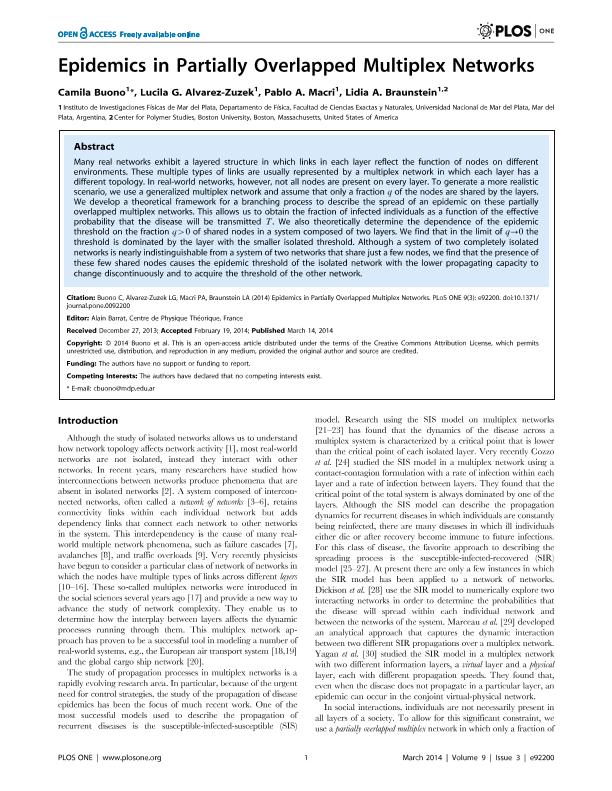Mostrar el registro sencillo del ítem
dc.contributor.author
Buono, Camila

dc.contributor.author
Alvarez Zuzek, Lucila Gisele

dc.contributor.author
Macri, Pablo Alejandro

dc.contributor.author
Braunstein, Lidia A.
dc.date.available
2016-11-15T19:25:51Z
dc.date.issued
2014-03
dc.identifier.citation
Buono, Camila; Alvarez Zuzek, Lucila Gisele; Macri, Pablo Alejandro; Braunstein, Lidia A.; Epidemics in Partially Overlapped Multiplex Networks; Public Library Of Science; Plos One; 9; 7; 3-2014; 92200-92205
dc.identifier.issn
1932-6203
dc.identifier.uri
http://hdl.handle.net/11336/8252
dc.description.abstract
Many real networks exhibit a layered structure in which links in each layer reflect the function of nodes on different environments. These multiple types of links are usually represented by a multiplex network in which each layer has a different topology. In real-world networks, however, not all nodes are present on every layer. To generate a more realistic scenario, we use a generalized multiplex network and assume that only a fraction q of the nodes are shared by the layers. We develop a theoretical framework for a branching process to describe the spread of an epidemic on these partially overlapped multiplex networks. This allows us to obtain the fraction of infected individuals as a function of the effective probability that the disease will be transmitted T. We also theoretically determine the dependence of the epidemic threshold on the fraction q of shared nodes in a system composed of two layers. We find that in the limit of q->0 the threshold is dominated by the layer with the smaller isolated threshold. Although a system of two completely isolated networks is nearly indistinguishable from a system of two networks that share just a few nodes, we find that the presence of these few shared nodes causes the epidemic threshold of the isolated network with the lower propagating capacity to change discontinuously and to acquire the threshold of the other network.
dc.format
application/pdf
dc.language.iso
eng
dc.publisher
Public Library Of Science

dc.rights
info:eu-repo/semantics/openAccess
dc.rights.uri
https://creativecommons.org/licenses/by/2.5/ar/
dc.subject
Epidemias
dc.subject
Percolacion
dc.subject
Redes Complejas
dc.subject.classification
Otras Ciencias Físicas

dc.subject.classification
Ciencias Físicas

dc.subject.classification
CIENCIAS NATURALES Y EXACTAS

dc.title
Epidemics in Partially Overlapped Multiplex Networks
dc.type
info:eu-repo/semantics/article
dc.type
info:ar-repo/semantics/artículo
dc.type
info:eu-repo/semantics/publishedVersion
dc.date.updated
2016-11-14T19:32:36Z
dc.journal.volume
9
dc.journal.number
7
dc.journal.pagination
92200-92205
dc.journal.pais
Estados Unidos

dc.journal.ciudad
San Francisco
dc.description.fil
Fil: Buono, Camila. Consejo Nacional de Investigaciones Científicas y Técnicas. Centro Científico Tecnológico Mar del Plata. Instituto de Investigaciones Físicas de Mar del Plata; Argentina
dc.description.fil
Fil: Alvarez Zuzek, Lucila Gisele. Consejo Nacional de Investigaciones Científicas y Técnicas. Centro Científico Tecnológico Mar del Plata. Instituto de Investigaciones Físicas de Mar del Plata; Argentina
dc.description.fil
Fil: Macri, Pablo Alejandro. Consejo Nacional de Investigaciones Científicas y Técnicas. Centro Científico Tecnológico Mar del Plata. Instituto de Investigaciones Físicas de Mar del Plata; Argentina
dc.description.fil
Fil: Braunstein, Lidia A.. Consejo Nacional de Investigaciones Científicas y Técnicas. Centro Científico Tecnológico Mar del Plata. Instituto de Investigaciones Físicas de Mar del Plata; Argentina. Boston University; Estados Unidos
dc.journal.title
Plos One

dc.relation.alternativeid
info:eu-repo/semantics/altIdentifier/url/http://www.plosone.org/article/info%3Adoi%2F10.1371%2Fjournal.pone.0092200
dc.relation.alternativeid
info:eu-repo/semantics/altIdentifier/doi/http://dx.doi.org/10.1371/journal.pone.0092200
Archivos asociados
